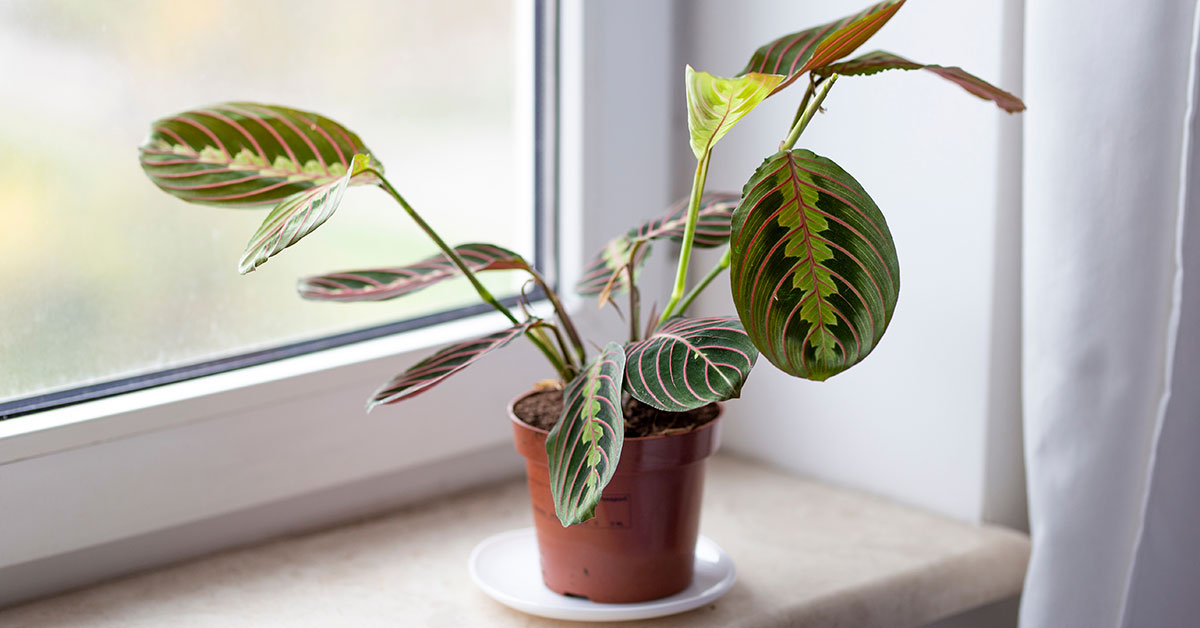To prune a prayer plant, cut back any yellow or dead leaves using clean, sharp scissors. Additionally, remove any leggy or overgrown stems to encourage new growth and maintain a compact shape.
Pruning should be done in the spring or early summer when the plant is actively growing. Regular pruning will help the prayer plant stay healthy and vibrant. The prayer plant, also known as Maranta leuconeura, is a popular houseplant known for its attractive and variegated leaves.
With its unique foliage patterns and low maintenance requirements, it is a favorite among plant enthusiasts. However, like any plant, it may benefit from occasional pruning to remove dead or damaged leaves and encourage new growth. Pruning is an important part of plant care as it helps maintain the plant’s shape, improve its appearance, and promote overall health. We will discuss the proper techniques for pruning a prayer plant to keep it looking its best.

Credit: www.reddit.com
When To Prune Prayer Plant
Pruning your prayer plant requires an understanding of its growth cycle. Timing is crucial for successful pruning. To determine when it’s time to prune, keep an eye out for signs such as overgrown or yellowing leaves. Pruning is beneficial for maintaining the plant’s shape and encouraging new growth.
Remember to use clean, sharp scissors or shears when pruning to prevent damage or infection. Start by removing any dead or dying leaves, cutting them off close to the stem. You can also trim back excessively long branches to maintain a compact shape.
Be sure to follow the natural growth pattern of the plant and avoid cutting into the main stem. By pruning your prayer plant at the right time and using proper techniques, you can keep it healthy and vibrant.
How to Prune Prayer Plant: Step by Step Guide
Tools And Preparation
Pruning your prayer plant requires essential tools and proper preparation. Before you begin, ensure your tools are clean by sterilizing them. Cleanliness is crucial to prevent any infections or diseases. Gather the necessary tools for the job, such as sharp pruning shears or scissors.
Make sure they are in good condition and ready for use. Additionally, have a clean cloth or paper towels on hand for wiping down tools between cuts. When pruning, remember to make clean cuts just above a leaf or bud node, ensuring the overall health and appearance of your plant.
Following these guidelines will help you successfully prune your prayer plant and maintain its beauty.
Prune Prayer Plant
To prune a prayer plant effectively, it is essential to assess its needs first. Identify the areas that require pruning, such as overgrown or damaged branches. Carefully make the necessary cuts, ensuring clean and precise incisions. This promotes healthy growth and helps the plant maintain its desired shape.
Regular pruning also encourages new growth and prevents the plant from becoming leggy or crowded. Remember to use sharp and clean pruning shears to prevent the spread of diseases. Additionally, avoid removing more than one-third of the plant at a time to minimize stress.
Following these steps will ensure that your prayer plant remains vibrant and attractive.
Pruning Techniques For Different Needs
Pruning the prayer plant, also known as Maranta leuconeura, is essential for its growth and overall health. One technique is pinching back the stems to encourage bushier growth. By removing the topmost section of the stem’s growth tip, you stimulate the plant to produce more lateral shoots and denser foliage.
Another pruning method involves cutting back leggy stems to restore balance and enhance aesthetics. Identifying long, stretched-out stems and trimming them promotes a more compact and visually appealing plant shape. Additionally, it’s crucial to regularly remove damaged or diseased leaves from the prayer plant.
This helps prevent further issues and ensures the overall well-being of the plant. Pruning the prayer plant not only enhances its appearance but also supports its growth and vitality.
Common Mistakes To Avoid
Pruning a prayer plant is essential for its growth, but it’s important to avoid certain mistakes. One common mistake is over-pruning, where finding the right balance is crucial. Cutting too much can harm the plant, so it’s best to trim only what is necessary.
Additionally, overlooking proper tool care can lead to the spread of diseases. It’s important to clean and sanitize the pruning tools before and after each use. Another mistake to avoid is cutting too close to the stem. Leaving a small distance promotes regrowth and prevents damage.
In conclusion, when pruning a prayer plant, remember to find the right balance, take care of your tools, and avoid cutting too close for a healthy and thriving plant.
Caring For Pruned Prayer Plant
Pruning a Prayer Plant is essential for its overall health and growth. After pruning, be mindful of its light and water requirements. Position the plant where it can receive moderate indirect light to prevent scorching and promote healthy foliage. Water the plant thoroughly, allowing the topsoil to dry slightly between waterings.
Post-pruning, it is important to monitor the plant’s health and growth progress. Regularly check for any signs of pests or diseases, and take appropriate measures to treat them. Additionally, fertilize the Prayer Plant after pruning, following the manufacturer’s instructions for timing and dosage.
By providing the proper care and attention, your pruned Prayer Plant will thrive and bring a touch of nature to your indoor space.
Frequently Asked Questions For How To Prune Prayer Plant
How Often Should I Prune My Prayer Plant?
Prune your prayer plant every 2-3 months to maintain its shape and promote healthy growth. Regular pruning helps remove dead or damaged leaves, encourages new growth, and prevents the plant from becoming too bushy.
Can I Use Regular Scissors To Prune My Prayer Plant?
Yes, you can use regular scissors to prune your prayer plant. Ensure the scissors are clean and sharp before starting. Trim away any yellow or brown leaves, cutting at a 45-degree angle. Avoid severe pruning as it may shock the plant and affect its overall health.
What Are The Signs That My Prayer Plant Needs Pruning?
Signs that your prayer plant needs pruning include overgrown foliage, yellowing or browning leaves, or a lack of new growth. Additionally, if the plant looks leggy or if you notice any disease or pest infestation, pruning can help alleviate these issues and promote a healthier plant.
How Should I Prune The Long Stems Of My Prayer Plant?
To prune long stems of your prayer plant, identify a node (the point where a leaf connects to the stem) and make a diagonal cut just above it. This encourages new growth and prevents lopsided growth. Don’t remove more than 1/3 of any stem to avoid stressing the plant.
Conclusion
Overall, pruning your prayer plant is a crucial step in keeping it healthy and vibrant. By following the proper techniques and guidelines, you can ensure that your prayer plant thrives and continues to beautify your space. Remember to first assess your plant’s specific needs, considering factors such as growth rate and desired shape.
Always use clean and sharp tools when cutting, making precise cuts just above a leaf node. Regularly inspect your plant for any signs of pests or disease, and take appropriate action if necessary. Lastly, be patient and observant, as it may take some time for your plant to adjust and respond to pruning.
With a little effort and care, your prayer plant will reward you with its lush foliage and stunning colors. Happy pruning!

